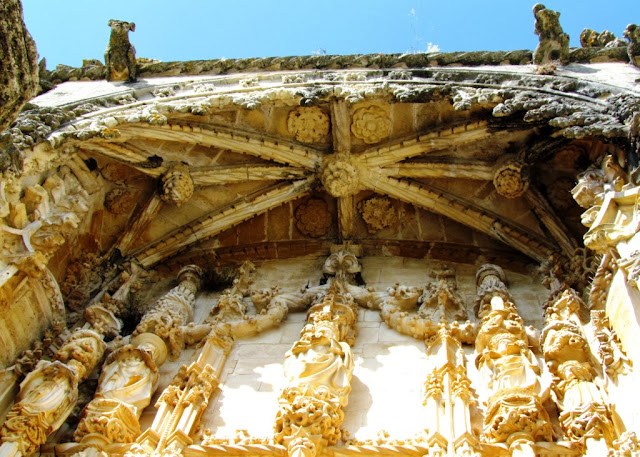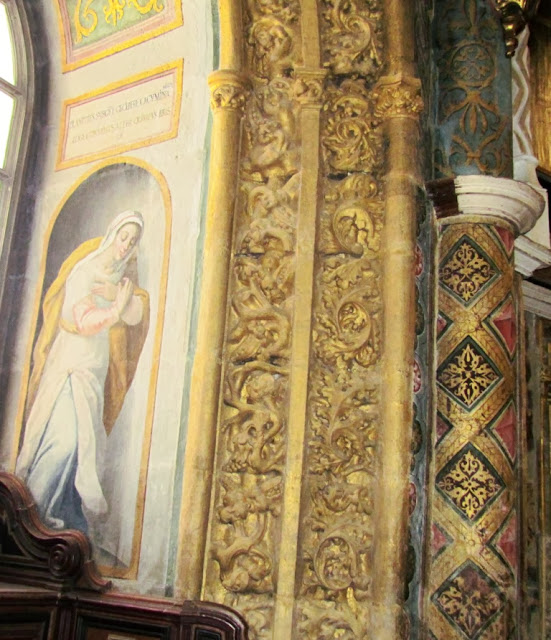AQUEDUCT OF PEGÕES ( TOMAR )
39° 36′ 31″ N, 8° 26′ 27″ W
The Aqueduct of the Convent of Christ, also called the Aqueduct of Pegões, was built with the purpose of supplying water to the Convent of Christ in Tomar from 4 different springs, and is about 6 km long, crossing the parishes of Carregueiros and the Union of Parishes of São João Baptista and Santa Maria dos Olivais, in the municipality of Tomar.
Its construction began in 1593, in the reign of Filipe I of Portugal, under the direction of Filipe Terzio, (chief architect of the kingdom) and was completed in 1614.
History
Upon becoming King of Portugal, Filipe II of Spain, it also came, by virtue of the crown, to be the Master of the Order of Christ. It was in this capacity that he commissioned Filipe Terzi (Filippo Terzi) to build an aqueduct that would supply the convent and the land around the Sete Montes (currently Mata Nacional) with abundant water.
Thus, a grandiose work of hydraulic engineering emerged in the architecture and convent landscape, covering an extension of about 6 kilometers, with a total of 180 arches for the aerial passages of the conduit. Particularly audacious is the stretch over the Pegões valley, made up of 58 full-round arches, in the deepest part of the valley resting on 16 broken arches, in turn erected on imposing masonry massifs: the "pegões".
Background
Although the cisterns of the Joanine convent (built in the various cloisters and supplied by the collection of rainwater) were sufficient for the needs of the friars, the water was insufficient for cultivating the land around the convent.
Construction and conservation
The layout of the aqueduct was executed in 1584 by Filipe Terzio, chief architect of the Kingdom, starting work in 1593. After the architect's death, the direction of the building work passed to Pedro Fernandes de Torres. The first phase of the work would only be completed in 1614, the date on which Philip II came to Portugal and inaugurated the work, as indicated by the engraved inscription on the aqueduct.
In 1616, with Diogo Marques Lucas already in charge of the work, the pipeline of the aqueduct was extended to the convent building, reaching the washbasin in the bedrooms the following year, and reaching the main cloister in 1619, the date on which the work was completed. . Its conclusion is marked by the Monumental Fountain of the Main Cloister (also known as the Cloister of the Philips).
Period of operation
The Aqueduct was in service from 1614 until the middle of the 20th century (more than 330 years).
Present
The monument (as a whole, covering more than 6km) is largely in an advanced state of degradation and abandonment, despite the layout being consolidated and the building intact, which will allow for its repair and conservation.
The upper sections, between springs, are the ones that show the most damage due to the abandonment of cultivated fields, currently taken over by vegetation and weeds.
Damage
Over the years and after the abandonment of the use of the aqueduct in the 17th century. XX, damages have been registered:
- Thefts of stone elements, covering slabs over the years;
- Damage to the source of Cano in the installation of a water conduit, 2005;
- Constructions and buildings adjoining the monument;
- Adventure sport activities (motocross, 4x4);
- Vandalism.
Characteristics
The morphology of this territory is composed of the intersection of a set of shallow valleys. The settlement of this space is characterized by the dispersion of small clusters and couples, mostly located next to road accesses, such as the village of Carregueiros and the place of Brasões.
On the slopes of the valleys, eucalyptus cultivation predominates, which has increased significantly in recent decades. In the low areas there are orchards and vineyards, and next to the water lines, vegetable gardens on small plots of land, with various structures for hydraulic use such as dams, canals and wells, as well as masonry walls that act as water basins. retention and infiltration (next to the 2 springs further north).
The aqueduct is a structure for transporting water with a linear length of 6223 m, made of stone piping, covered with slabs, running largely at ground level, with about 400 m built on arcades (air sections that make up a total of 180 perfect back arcs). It is fed by four underground springs, the water being transported by limestone gutters in half canes, by gravity.
The insertion of this hydraulic system in the territory begins at an altitude of 153.43 m upstream, at the source of the pipe, and ends at an altitude of 127.15 m, downstream, at the point of intersection with the roof of the convent building, overcoming this forms 26.28 meters of unevenness. Under the principle of gravitational force, the aqueduct of the Convent of Christ maintains a slope from upstream to downstream with inclinations that vary between 0.2% and 1.5% for most of its length.
In the steepest area, over the Pegões valley, the arches are based on a set of 16 broken arches. At the ends of the structure, two mothers of water were built, externally topped by domes, and which in the vaulted interior house large basins for the purification of water.
Aerial section of the Felpinheira valley
The aerial stretches of the Felpinheira valley are made up of twelve round arches, measuring around 15 meters at the highest point.
Monumental aerial section [of the valley] of Pegões
The aqueduct has 58 round arches, in its highest part, over 16 pointed arches supported by pillars. Its maximum height is 30 meters. At the ends, it has vaulted water houses, which have a large sink in the center for decanting water.
In the water house downstream of Ribeira do Choupal, the inscription:
"THE UNVICTED AND VERY CATHOLIC KING D. PHILIP I OF THE NAME, OF PIA MEMORIA, WITH REAL LIBERALITY, ORDERED THIS AQUEDUCT TO BE MADE IN THE YEAR 1593 / WITH THE SAME, THE AUGUST ISSUE AND CHRISTIAN KING D. PHILIP HIS SECOND SON OF NAME MADE IT FINISH 1613"
There are 34 round arches, which cross a shallow valley, and running parallel to the fence wall are 2 arches with 18 and 13 arches;
Adduction
Drinking water is transported from the most remote spring to the convent by gravity, in open limestone gutters with a semicircular cross-section, joined together by a chamfered male-female fitting, with consolidation and waterproofing mortar.
The volumetry of the archetypal gutter that conducts the water is defined in a rectangular prism, hollowed out by a half-ellipse cross-section measuring 0.31 m on the major axis and 0.17 m on the minor axis, is 1.74 m long and its external width oscillates between 0.49 m and 0.57 m, in thickness it measures 0.22 m. This rests on the base of the conduit, gallery or building and presents section variations along the transport, from upstream to downstream. It is immediately after the source of Porta de Ferro that the minor axis of the ellipse of the gutter section starts to register 0.30 m, showing the increase in the flow captured in this source.
Surface sections
They correspond to 66.3% of the set, equivalent to 4,127.46 m, divided into fifteen sections of varying lengths, with the longest section 738.74 m long and the smallest 12.00 m.
Aerial sections
They correspond to 25.6% of the set, equivalent to 1,596.88 m, divided into eleven sections of varying lengths, with the longest section in the Pegões valley measuring 612.12 m and the smallest measuring 40.00 m, along instead of Casal Ribeiro.
Buried sections
They correspond to 8.1% of the set, equivalent to 506.66 m, divided into five sections of varying lengths, the longest section having 310.00 m and the smallest 31.00 m.
Cadeira d'El Rei reservoir and water distribution
Reaching the convent fence, the aqueduct would flow into a large irrigation tank, which distributed water to irrigate the fence, to the oil press (currently in ruins) and to the convent's hydraulic system.
On the outer side of the fence, where a door would have been, a Latin inscription was placed in a frame referring to the execution of the first phase of the work:
"The extensive aqueduct and very high mole that a short while ago, crawling, was erected by favor of kings, cutting through the mountains, crossing deep valleys, despite the strength of work and money, on a long journey led here or rather led by the two Philips: the that the arms of so many kings did not make. 1614".
Between the Cadeira d'El Rei and the Convent, the route initially develops in a superficial section and next to the old wine press, running parallel to the fence wall 2 arches with 18 and 13 arches.
Finally, the aqueduct reaches the Convent building in a curtain of 21 arches, also round, topped by the cross of Christ, in which the latter are adjacent to the south façade.
















































































































































































































